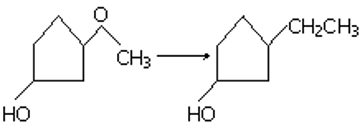Aldehydes Ketones and Carboxylic Acids - Online Test
Q1. One mole of a symmetrical alkane on ozonolysis gives two moles of an aldehyde having molecular mass of 44u. The alkene is.
Answer : Option A
Explaination / Solution:
2-butene on reductive ozonolysis will give CH3CHO which has molecular mass of 44u.
Q2. The compound formed as a result of oxidation of ethyl benzene by KMnO4 is
Answer : Option B
Explaination / Solution:


Q3. Ketones are reduced to the corresponding alcohols by catalytic hydrogenation to form
Answer : Option B
Explaination / Solution:
Ketones reduction give secondary alcohols.
Q4. Which of the following is correct?
Answer : Option C
Explaination / Solution:
C2H5OH get oxidizes to CH3CHO and –COCH3 group is important for iodoform.
Q5. Reduction of aldehydes and ketones into hydrocarbons using zinc amalgam and conc. HCl is called
Answer : Option C
Explaination / Solution:
Clemmenson is the reaction of carbonyl compounds with Zn amalgam in presence of conc. HCl to convert them to alkanes.
Q6. The appropriate reagent for the transformation:


Answer : Option D
Explaination / Solution:
For this reaction wolff Kishner reaction is used as –OH is acid sensitive group so clemmson cannot be used.
Q7. A mixture of benzaldehyde and formaldehyde on heating with aqueous NaOH solution gives
Answer : Option C
Explaination / Solution:
They will undergo cannizaro reaction.
Q8. Which of the following has most acidic hydrogen?
Answer : Option B
Explaination / Solution:
2,4-hexanedione will have active metylene group.
Q9. Clemmensen reduction of a ketone is carried out in the presence of which of the following?
Answer : Option C
Explaination / Solution:
For Clemmenson we use Zn-Hg( conc HCl )
Q10. Which of the following statements is not correct?
Answer : Option C
Explaination / Solution:
Aldehydes and ketones have polar C=O group therefore they undergo nucleophilic addition reactions.
